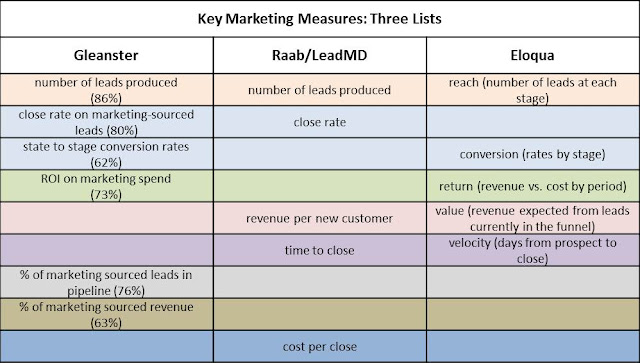Marketing measurement is a perennially popular topic. I myself have just completed a white paper on Top Five Metrics for Revenue Generation Marketers, sponsored by LeadMD, and touched on it in a separate Gleanster study, Revenue Performance Management – The Evolution of Marketing Automation. With both of these on my mind, I also paid new attention to Eloqua‘s list of five key revenue performance indicators (listed in the ‘Take a tour’ graphic on this page). The obvious question was whether these three sources agreed about what’s important.
The answer is: not exactly. The following table compares the top metrics from each paper, with analogous items on the same row:
The only item that’s clearly shared across all three lists is the number of leads generated, and even that takes a bit of squinting to include Eloqua’s measure of “reach”, which is really the number of leads currently at different stages. You could also argue that close rate and conversion rates are pretty much the same thing, and therefore also present on all three lists. (Again, a bit of squinting is required). Three of the other items appear just twice (return on investment, revenue, and time to close). The remaining three occur just once.
What accounts for the inconsistencies? I’d say mostly it’s the nature of the lists. The Gleanster list is from a survey of what marketers actually do: it’s no accident that nearly all items are quite easy to calculate. (Return on investment is a glaring exception, and I very much doubt that 73% of marketers actually calculate it today. So let’s just assume that figure is aspirational.)
The other two lists are prescriptive: that is, they show what an expert feels should be done, not what marketers actually do. Look closely, and you’ll see that the lists are quite similar. Four of the five measures are shared. Even the two non-matching items are related: my fifth item is cost and Eloqua’s is return, which is a combination of cost and revenue.
The apparent difference between the lists is that mine looks more simplistic. It starts with a three-part formula for calculating revenue: (number of leads) x (close rate) x (revenue per closed lead). A fourth factor, cost, combines with revenue to create return on investment. The fifth factor, time, is needed to forecast revenue by period.
Eloqua’s list breaks those same factors down by stages. That is, instead of a single close rate is has a set of conversion rates from one stage to the next. It similarly breaks number of leads into reach (number of leads at each stage), revenue into value (expected revenue from leads at each stage), and time into velocity (number of days spent at each stage). This makes total sense, and if you read my paper, you’ll see that I recommend breaking the measures into stages in almost exactly the same way.* The reason is that reporting on stages gives much greater insight into what’s working well or poorly, and thus helps marketers to see where they should make changes. Providing this sort of actionable information is probably the most important purpose for any measurement system.
In short, Eloqua and I pretty much agree on what marketers should measure. Now if the marketers themselves would join the consensus.
______________________________________________________________________________
* The paper also gives plenty of sage advice on how to actually build a system based on these measures.




